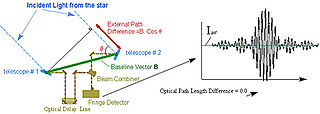
Astrometry is a branch of astronomy that involves precise measurements of the positions and movements of stars and other celestial bodies. It provides the kinematics and physical origin of the Solar System and this galaxy, the Milky Way.

The United States Naval Observatory (USNO) is a scientific and military facility that produces geopositioning, navigation and timekeeping data for the United States Navy and the United States Department of Defense. Established in 1830 as the Depot of Charts and Instruments, it is one of the oldest scientific agencies in the United States, and remains the country's leading authority for astronomical and timing data for all purposes.
GSC 02652-01324 is an orange dwarf main sequence star approximately 521 light-years away in the constellation of Lyra.

Omicron Persei is a triple star system in the constellation of Perseus. From parallax measurements taken during the Hipparcos mission it is approximately 1,100 light-years from the Sun.
HD 895 is a multiple star system in the constellation Andromeda. Its apparent magnitude is 6.277, so it can be seen by the naked eye under very favourable conditions. Based on parallax measured by Hipparcos, the system is located around 54 parsecs (180 ly) away, and it is made of two different spectroscopic binary pairs.
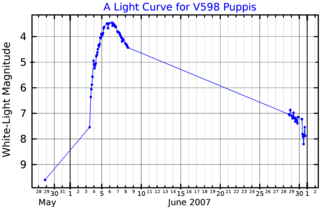
V598 Puppis is the name given to a nova in the Milky Way Galaxy. USNO-A2.0 0450-03360039, a catalog number for the star, was discovered to be much brighter than normal in X-ray emissions on October 9, 2007, by the European Space Agency's XMM-Newton telescope. The star was confirmed to be over 10 magnitudes, or 10,000 times, brighter than normal by the Magellan-Clay telescope Magellan-Clay telescope at Las Campanas Observatory in Chile. Pre-discovery images and identification of the progenitor would ultimately shows that the nova brightened from visual magnitude 16.6 to brighter than magnitude 4.
HD 145377 is a star in the southern constellation Scorpius. It has an apparent visual magnitude of 8.10 and can be viewed with a small telescope. The star is located at a distance of 175 light years from the Sun based on parallax, and it is drifting further away with a radial velocity of +11.6. The absolute magnitude of this star is 4.31, indicating it would be visible to the naked eye if it were at a distance of 10 parsecs.

XZ Tauri is a binary system approximately 460 light-years away in the constellation Taurus. The system consists of two T Tauri stars orbiting each other about 6 billion kilometers apart. The system made news in 2000 when a superflare was observed in the system.
HD 9578 is a candidate wide binary star system located at a distance of approximately 183 light-years from the Sun in the southern constellation of Sculptor. The main star must be viewed with binoculars or a telescope, as its low apparent visual magnitude of 8.35 is too faint to be viewed with the naked eye. The system is drifting closer to the Sun with a radial velocity of −4 km/s.
HD 13931 is a Sun-like star in the northern constellation of Andromeda. It can be viewed with binoculars or a small telescope but is too faint to be seen with the naked eye, having an apparent visual magnitude of 7.60. This object is located at a distance of 154 light years from the Sun, as determined from its parallax, and is drifting further away with a radial velocity of +31 km/s.

C/2012 K1 (PanSTARRS) is a retrograde Oort cloud comet discovered at magnitude 19.7, 8.7 AU from the Sun on 17 May 2012 using the Pan-STARRS telescope located near the summit of Haleakalā, on the island of Maui in Hawaii (U.S.).

Mars has an orbit with a semimajor axis of 1.524 astronomical units, and an eccentricity of 0.0934. The planet orbits the Sun in 687 days and travels 9.55 AU in doing so, making the average orbital speed 24 km/s.
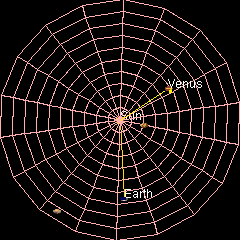
Venus has an orbit with a semi-major axis of 0.723 au, and an eccentricity of 0.007. The low eccentricity and comparatively small size of its orbit give Venus the least range in distance between perihelion and aphelion of the planets: 1.46 million km. The planet orbits the Sun once every 225 days and travels 4.54 au in doing so, giving an average orbital speed of 35 km/s (78,000 mph).
EPIC 204278916 is a pre-main-sequence star, about five million years old with a spectral type of M1, implying a red dwarf. It is part of the Upper Scorpius sub-group of the Scorpius–Centaurus association, and is in the constellation Scorpius. The star is approximately the size of the Sun at 0.97 R☉, but is only half its mass (0.50 M☉) and a fraction of its luminosity (0.15 L☉).

WZ Andromedae is an eclipsing binary star in the constellation Andromeda. Its maximum apparent visual magnitude is 11.6, but drops down to 12.00 during the main eclipse which occurs roughly every 16.7 hours.
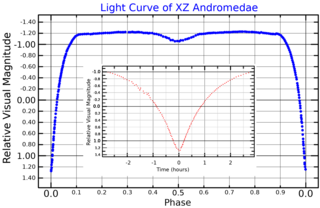
XZ Andromedae is a binary star in the constellation Andromeda. Its maximum apparent visual magnitude is 9.91, but drops down to 12.45 every 1.357 days. Its variability matches the behaviour of Algol variable stars.
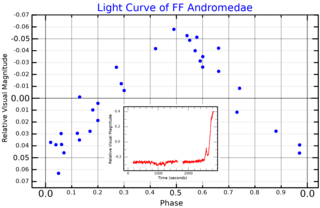
FF Andromedae is a spectroscopic binary in the constellation Andromeda. It has a typical apparent visual magnitude of 10.4, but undergoes flare events that can increase its brightness by about a magnitude.
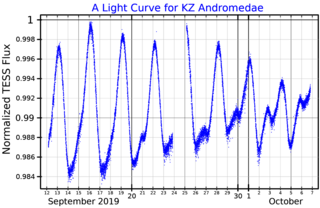
KZ Andromedae is a double lined spectroscopic binary in the constellation Andromeda. Its apparent visual magnitude varies between 7.91 and 8.03 during a cycle slightly longer than 3 days.
GSC 03949-00967 is a G-type main-sequence star about 1179 light-years away. It is older than the Sun, yet is enriched by heavy elements compared to the Sun, having 160% of solar abundance.












